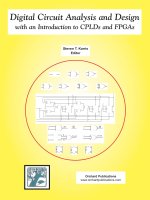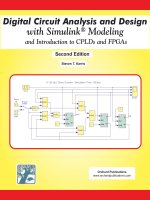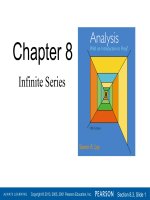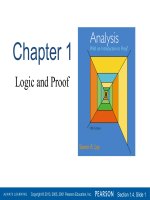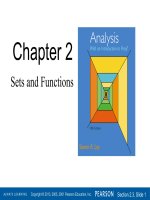Digital Circuit Analysis and Design with an Introduction to
Bạn đang xem bản rút gọn của tài liệu. Xem và tải ngay bản đầy đủ của tài liệu tại đây (10.56 MB, 448 trang )
J
Q
Q
K
SET
CLR
A
A
B
AB
AB AB
A
B
B
A
B
A
+
B
A
B
A
+
B
Q
Q
SET
CLR
D
Q
Q
SET
CLR
S
R
Orchard Publications
www.orchardpublications.com
Digital Circuit Analysis and Design
with an Introduction to CPLDs and FPGAs
Steven T. Karris
Editor
$49.95 U.S.A.
ISBN 0-9744239-5-5
Orchard Publications
Visit us on the Internet
www.orchardpublications.com
or email us:
Steven T. Karris is the president and founder of Orchard Publications. He earned a bachelors
degree in electrical engineering at Christian Brothers University, Memphis, Tennessee, a masters
degree in electrical engineering at Florida Institute of Technology, Melbourne, Florida, and has done
post-master work at the latter. He is a registered professional engineer in California and Florida. He
has over 35 years of professional engineering experience in industry. In addition, he has over 30
years of teaching experience that he acquired at several educational institutions as an adjunct pro-
fessor. He was formerly with UC Berkeley Extension.
This text includes the following chapters and appendices:
• Common Number Systems and Conversions • Operations in Binary, Octal, and Hexadecimal
Systems • Sign Magnitude and Floating Point Arithmetic • Binary Codes • Fundamentals of Boolean
Algebra • Minterms and Maxterms • Combinational Logic Circuits • Sequential Logic
Circuits • Memory Devices • Advanced Arithmetic and Logic Operations • Introduction to Field
Programmable Devices • Introduction to the ABEL Hardware Description Language
• Introduction to VHDL • Introduction to Verilog • Introduction to Boundary-Scan Architecture
Each chapter contains numerous practical applications. This is a design-oriented text.
Students and working professionals will
find Digital Circuit Analysis and Design with
an Introduction to CPLDs and FPGAs, to be
a concise and easy-to-learn text. It pro-
vides complete, clear, and detailed expla-
nations of the state-of-the-art electronic
digital circuits. All topics are illustrated
with many real-world examples.
Digital Circuit
Analysis and Design
with an Introduction to CPLDs & FPGAs
Digital Circuit Design
with an Introduction to
CPLDs and FPGAs
Steven T. Karris
Editor
Orchard Publications
www.orchardpublications.com
Digital Circuit Design with an Introduction to CPLDs and FPGAs
Copyright ” 2005 Orchard Publications. All rights reserved. Printed in the United States of America. No part of this
publication may be reproduced or distributed in any form or by any means, or stored in a data base or retrieval system,
without the prior written permission of the publisher.
Direct all inquiries to Orchard Publications,
Product and corporate names are trademarks or registered trademarks of Xilinx, Inc., Altera, Inc. Cypress
Semiconductor, Lattice, Inc., and Atmel, Inc. They are used only for identification and explanation, without intent to
infringe.
Library of Congress Cataloging-in-Publication Data
Library of Congress Control Number (LCCN) 2005929326
Copyright TX 5-612-942
ISBN 0-9744239-5-5
Disclaimer
The author has made every effort to make this text as complete and accurate as possible, but no warranty is implied.
The author and publisher shall have neither liability nor responsibility to any person or entity with respect to any loss
or damages arising from the information contained in this text.
Preface
This book is an undergraduate level textbook presenting a thorough discussion of state-of-the-art
digital devices and circuits. It supplements our Electronic Devices and Amplifier Circuits, ISBN 0-
9744239-4-7. It is self-contained; begins with the basics and ends with the latest developments of
the digital technology. The intent is to prepare the reader for advanced digital circuit design and
programming the powerful Complex Programmable Logic Devices (CPLDs), and Field
Programmable Gate Arrays (FPGAs).
The prerequisites for this text are just basic high-school math; Accordingly, it can be read and
understood by high-school seniors, trade-school, community college, and 4-year university
students. It is ideal for self-study.
The author and contributors make no claim to originality of content or of treatment, but have
taken care to present definitions, statements of physical laws, theorems, and problems.
Chapter 1 is an introduction to the decimal, binary, octal, and hexadecimal numbers, their
representation, and conversion from one base to another. Chapter 2 presents an introduction to
arithmetic operations in binary, octal, and hexadecimal numbers. The tens complement and nines
complements in the decimal system and the twos complement and ones complements in the
binary system are discussed and illustrated with numerous examples. Chapter 3 begins with an
introduction to sign magnitude representation of binary numbers. It concludes with a discussion
on floating point arithmetic for representing large numbers and the IEEE standard that specifies
single precision (32 bit) and double precision (64 bit) floating point representation of numbers.
Chapter 4 describes the most commonly used binary codes. The Binary Coded Decimal (BCD),
the Excess-3 Code, the 2*421 Code, the Gray Code, and the American Standard Code for
Information Interchange (ASCII) code are introduced as well as the use of parity bits. Chapter 5
begins with the basic logic operations and continues with the fundamentals of Boolean algebra
and the basic postulates and theorems as applied to electronic logic circuits. Truth tables are
defined and examples are given to illustrate how they can be used to prove Boolean algebra
theorems or equivalent logical expressions. Chapter 6 introduces the standard forms of expressing
Boolean functions; the minterms and maxterms, also known as standard products and standard
sums respectively. A procedure is also presented to show how one can convert one form to the
other. This topic is essential in understanding the programming of Programmable Logic Arrays
(PLAs) discussed in Chapter 11.
Chapter 7 is an introduction to combinational logic circuits. It begins with methods of
implementing logic diagrams from Boolean expressions, the derivation of Boolean expressions
from logic diagrams, input and output waveforms, and the use of Karnaugh maps for simplifying
Boolean expressions. Chapter 8 is an introduction to sequential logic circuits. It begins with a
discussion of the different types of flip flops, and continues with the analysis and design of binary
counters, registers, ring counters, and ring oscillators. Chapter is an introduction to computer
memory devices. We discuss the random-access memory (RAM), read-only memory (ROM), row
and column decoders, memory chip organization, static RAMs (SRAMs) dynamic RAMs
(DRAMs), volatile, nonvolatile, programmable ROMs (PROMs), Erasable PROMs (EPROMs),
Electrically Erasable PROMs (EEPROMs), flash memories, and cache memory. Chapter 10 begins
with an introduction to the basic components of a digital computer. It continues with a discussion
of the basic microprocessor operations, and concludes with the description of more advanced
arithmetic and logic operations.
We consider Chapter 11 as the highlight of this text. It is an introduction to Field Programmable
Devices (FPDs), also referred to as Programmable Logic Devices (PLDs). It begins with the
description and applications of Programmable Logic Arrays (PLAs), continues with the
description of Simple PLDs (SPLDs) and Complex PLDs (CPLDs), and concludes with the
description of Field Programmable Gate Arrays (FPGAs).
This text includes also four appendices; Appendix A is an overview of the Advanced Boolean
Equation Language (ABEL) which is an industry-standard Hardware Description Language
(HDL) used in Programmable Logic Devices (PLDs). Appendix B describes the VHSIC Hardware
Description Language briefly referred to as VHDL. This language was developed to be used for
documentation, verification, and synthesis of large digital designs. Appendix C introduces the
Verilog Hardware Description Language (HDL). Like VHDL introduced in Appendix B, Verilog
is a programming language used to describe a digital system and its components. Appendix D is a
brief discussion on the boundary-scan architecture and the new technology trends that make
using boundary-scan essential for the reduction in development and production costs.
This is our eighth science and electrical and computer engineering-related text. My associates,
contributors, and I have a mission to produce substance and yet inexpensive texts for the average
reader. Our texts are very popular with students and working professionals seeking to enhance
their knowledge and prepare for the professional engineering examination. We are working with
limited resources and our small profits realized after large discounts to the bookstores and
distributors, are reinvested in the production of more texts. To maintain our retail prices as low as
possible, we avoid expensive and fancy hardcovers.
Like any other new text, the readers will probably find some mistakes and typo errors for which we
assume responsibility. We will be grateful to readers who direct these to our attention at
Thank you.
Orchard Publications
Fremont, California 94538-4741
United States of America
www.orchardpublications.com
Digital Circuit Design with an Introduction to CPLDs and FPGAs i
Orchard Publications
Table of Contents
Chapter 1
Common Number Systems and Conversions
Decimal, Binary, Octal, and Hexadecimal Systems 1-1
Binary, Octal, and Hexadecimal to Decimal Conversions 1-3
Decimal to Binary, Octal, and Hexadecimal Conversions 1-3
Binary-Octal-Hexadecimal Conversions 1-7
Summary 1-9
Exercises 1-11
Solutions to End-of-Chapter Exercises 1-12
Chapter 2
Operations in Binary, Octal, and Hexadecimal Systems
Binary System Operations 2-1
Octal System Operations 2-2
Hexadecimal System Operations 2-5
Complements of Numbers 2-6
Tens-Complement 2-7
Nines-Complement 2-7
Twos-Complement 2-8
Ones-Complement 2-9
Subtraction with Tens- and Twos-Complements 2-10
Subtraction with Nines- and Ones-Complements 2-11
Summary 2-14
Exercises 2-16
Solutions to End-of-Chapter Exercises 2-1
8
Chapter 3
Sign Magnitude and Floating Point Arithmetic
Signed Magnitude of Binary Numbers 3-1
Floating Point Arithmetic 3-2
The IEEE Single Precision Floating Point Arithmetic 3-3
The IEEE Double Precision Floating Point Arithmetic 3-7
Summary 3-9
Exercises 3-10
Solutions to-End-of-Chapter Exercises 3-11
ii Digital Circuit Design with an Introduction to CPLDs and FPGAs
Orchard Publications
Chapter 4
Binary Codes
Encoding 4-1
Binary Coded Decimal (BCD) 4-1
The Excess-3 Code 4-2
The 2*421 Code 4-3
The Gray Code 4-4
The American Standard Code for Information Interchange (ASCII) Code 4-5
The Extended Binary Coded Decimal Interchange Code (EBCDIC) 4-8
Parity Bits 4-8
Error Detecting and Correcting Codes 4-9
Cyclic Codes 4-9
Summary 4-14
Exercises 4-16
Solutions to End-of-Chapter Exercises 4-17
Chapter 5
Fundamentals of Boolean Algebra
Basic Logic Operations 5-1
Fundamentals of Boolean Algebra 5-1
Postulates 5-1
Theorems 5-2
Truth Tables 5-3
Summary 5-5
Exercises 5-7
Solutions to End-of Chapter Exercises 5-8
Chapter 6
Minterms and Maxterms
Minterms 6-1
Maxterms 6-2
Conversion from One Standard Form to Another 6-3
Properties of Minterms and Maxterms 6-4
Summary 6-9
Exercises 6-10
Solutions to End-of-Chapter Exercises 6-12
Digital Circuit Design with an Introduction to CPLDs and FPGAs iii
Orchard Publications
Chapter 7
Combinational Logic Circuits
Implementation of Logic Diagrams from Boolean Expressions 7-1
Obtaining Boolean Expressions from Logic Diagrams 7-9
Input and Output Waveforms 7-11
Karnaugh Maps (K-maps) 7-12
K-map of Two Variables 7-12
K-map of Three Variables 7-14
K-map of Four Variables 7-14
General Procedures for Using a K-map of n Squares 7-16
Don’t Care Conditions 7-20
Design of Common Logic Circuits 7-21
Parity Generators/Checkers 7-21
Digital Encoders 7-23
Decimal-to-BCD Encoder 7-26
Digital Decoders
7-28
Equality Comparators 7-32
Multiplexers and Demultiplexers 7-36
Arithmetic Adder and Subtractor Logic Circuits 7-42
Summary 7-48
Exercises 7-50
Solutions to End-of-Chapter Exercises 7-53
Chapter 8
Sequential Logic Circuits
Introduction to Sequential Circuits 8-1
Set-Reset (SR) Flip Flop 8-1
Data (D) Flip Flop 8-4
JK Flip Flop 8-5
Toggle (T) Flip Flop 8-6
Flip Flop Triggering 8-7
Edge-Triggered Flip Flops 8-8
Master / Slave Flip Flops 8-8
Conversion from One Type of Flip Flop to Another 8-11
Analysis of Synchronous Sequential Circuits 8-13
Design of Synchronous Counters 8-22
Registers 8-27
Ring Counters
8-32
Ring Oscillators 8-35
iv Digital Circuit Design with an Introduction to CPLDs and FPGAs
Orchard Publications
Summary 8-36
Exercises 8-39
Solutions to End-of-Chapter Exercises 8-42
Chapter 9
Memory Devices
Random-Access Memory (RAM) 9-1
Read-Only Memory (ROM) 9-3
Programmable Read-Only Memory (PROM) 9-6
Erasable Programmable Read-Only Memory (EPROM) 9-7
Electrically-Erasable Programmable Read-Only Memory (EEPROM) 9-8
Flash Memory 9-8
Cache Memory 9-9
Virtual Memory 9-9
Scratch Pad Memory 9-10
Summary 9-11
Exercises 9-13
Solutions to End-of-Chapter Exercises 9-14
Chapter 10
Advanced Arithmetic and Logic Operations
Computers Defined 10-1
Basic Digital Computer System Organization and Operation 10-2
Parallel Adder 10-4
Serial Adder 10-5
Overflow Conditions 10-6
High-Speed Addition and Subtraction 10-9
Binary Multiplication 10-10
Binary Division 10-13
Logic Operations of the ALU 10-14
Other ALU functions 10-15
Summary 10-16
Exercises 10-18
Solutions to End-of-Chapter Exercises 10-19
Digital Circuit Design with an Introduction to CPLDs and FPGAs v
Orchard Publications
Chapter 11
Introduction to Field Programmable Devices
Programmable Logic Arrays (PLAs) 11-1
Programmable Array Logic (PAL) 11-5
Complex Programmable Logic Devices (CPLDs) 11-6
The Altera MAX 7000 Family of CPLDs 11-7
The AMD Mach Family of CPLDs 11-12
The Lattice Family of CPLDs 11-14
Cypress Flash370 Family of CPLDs 11-15
Xilinx XC9500 Family of CPLDs 11-20
CPLD Applications 11-30
Field Programmable Gate Arrays (FPGAs) 11-36
SRAM-Based FPGA Architecture 11-37
Xilinx FPGAs 11-37
Atmel FPGAs 11-40
Altera FPGAs
11-40
Lattice FPGAs 11-42
Antifuse-Based FPGAs 11-43
Actel FPGAs 11-43
QuickLogic FPGAs 11-49
FPGA Block Configuration - Xilinx FPGA Resources 11-50
The CPLD versus FPGA Trade-Off 11-58
What is Next 11-58
Summary 11-61
Exercises 11-63
Solutions to End-of-Chapter Exercises 11-65
Appendix A
Introduction to ABEL Hardware Description Language
Introduction A-1
Basic Structure of an ABEL Source File A-1
Declarations in ABEL A-3
Numbers in ABEL A-5
Directives in ABEL A-6
The @alternate Directive in ABEL A-6
The @radix Directive in ABEL A-7
The @standard Directive in ABEL A-7
Sets in ABEL A-7
Indexing or Accessing a Set in ABEL A-8
vi Digital Circuit Design with an Introduction to CPLDs and FPGAs
Orchard Publications
Set Operations in ABEL A-9
Operators in ABEL A-11
Logical Operators in ABEL A-11
Arithmetic Operators in ABEL A-12
Relational Operators in ABEL A-12
Assignment Operators in ABEL A-13
Operator Priorities in ABEL A-13
Logic Description in ABEL A-14
Equations in ABEL A-14
Truth Tables in ABEL A-15
State Diagram in ABEL A-18
Dot Extensions in ABEL A-21
Test Vectors in ABEL
A-22
Property Statements in ABEL A-23
Active-Low Declarations in ABEL A-23
Appendix B
Introduction to VHDL
Introduction B-1
The VHDL Design Approach B-1
VHDL as a Programming Language B-3
Elements B-4
Comments B-4
Identifiers B-4
Literal Numbers B-4
Literal Characters B-5
Literal Strings B-5
Bit Strings B-5
Data Types B-6
Integer Types
B-6
Physical Types B-7
Floating Point Types B-8
Enumeration Types B-9
Arrays B-9
Records B-11
Subtypes B-11
Object Declarations B-12
Attributes B-13
Expressions and Operators B-14
Sequential Statements B-15
Digital Circuit Design with an Introduction to CPLDs and FPGAs vii
Orchard Publications
Variable Assignments B-15
If Statement B-16
Case Statement B-16
Loop Statements B-17
Null Statement B-19
Assertions B-19
Subprograms and Packages B-20
Procedures and Functions B-20
Overloading B-23
Package and Package Body Declarations B-24
Package Use and Name Visibility B-26
Structural Description B-26
Entity Declarations
B-26
Architecture Declarations B-29
Signal Declarations B-30
Blocks B-30
Component Declarations B-32
Component Instantiation B-33
Behavioral Description B-33
Signal Assignment B-33
Process and the Wait Statement B-35
Concurrent Signal Assignment Statements B-38
Conditional Signal Assignment B-38
Selected Signal Assignment B-40
Organization B-41
Design Units and Libraries
B-42
Configurations B-43
Detailed Design Example B-47
Appendix C
Introduction to Verilog
Description C-1
Verilog Applications C-2
The Verilog Programming Language C-2
Lexical Conventions C-6
Program Structure C-7
Data Types Defined C-9
Physical Data Types C-9
Abstract Data Types C-11
Operators Defined C-11
viii Digital Circuit Design with an Introduction to CPLDs and FPGAs
Orchard Publications
Binary Arithmetic Operators C-11
Unary Arithmetic Operators C-12
Relational Operators C-12
Logical Operators C-12
Bitwise Operators C-12
Unary Reduction Operators C-13
Other Operators C-13
Operator Precedence C-14
Control Statements C-15
Selection Statements C-15
Repetition Statements C-16
Other Statements C-16
Parameter Statements
C-17
Continuous Assignment Statements C-17
Blocking Assignment Statements C-17
Non-Blocking Assignment Statements C-18
System Tasks C-19
Functions C-21
Timing Control C-22
Delay Control C-22
Event Control C-22
Wait Control C-22
Fork and Join Control C-23
Appendix D
Introduction to Boundary Scan Architecture
The IEEE Standard 1149.1 D-1
Introduction D-1
Boundary Scan Applications D-3
Board with Boundary-Scan Components D-4
Field Service Boundary-Scan Applications D-5
Digital Circuit Analysis and Design with an Introduction to CPLDs and FPGAs 1-1
Orchard Publications
Chapter 1
Common Number Systems and Conversions
his chapter is an introduction to the decimal, binary, octal, and hexadecimal numbers, their
representation, and conversion from one base to another. The conversion procedures are
illustrated with several examples.
1.1 Decimal, Binary, Octal, and Hexadecimal Systems
The familiar decimal number system has base or radix . It referred to as base because it uses
ten digits . These digits are referred to as the coefficients of the decimal
system. Thus, in the decimal system the coefficients are multiplied by the appropriate powers of
10 to form a number. For example, the decimal number is interpreted as:
In general, any number may be represented by a series of coefficients as:
In the decimal system, the coefficients are the ten coefficients (zero through nine), and the
subscript value denotes the power of ten by which the coefficient must be multiplied. Thus, the
last expression above can also be written as
Digital computers use the binary (base 2) system which has only two coefficients, and . In the
binary system each coefficient is multiplied by . In general, a number of base or radix with
coefficients is expressed as
(1.1)
The number could be interpreted as a binary, or decimal or any other base number
since the coefficients and are valid in any number with base 2 or above. Therefore, it is a rec-
ommended practice to enclose the number in parenthesis and write a subscript representing the
base of the number. Thus, if the number is binary, it is denoted as
T
10 10
012345678and 9,,,,,,,,,
58 392.46,
58 392.46, 50 000 8 000 300 90 2 0.4 0.06+++++,+,=
510
4
× 810
3
× 310
2
× 910
1
× 210
0
× 410
1–
× 610
2–
×+++++ +=
A
n
A
n1–
A
n2–
……A
2
A
1
A
0
.A
1–
A
2–
……A
n–
A
k
k
A
n
10
n
⋅ A
n1–
10
n1–
⋅ A
n2–
10⋅
n2–
++ …+A
2
10
2
A+
1
10
1
A
0
10
0
A
1–
10
1–
…+A
n–
10
n–
⋅+⋅+⋅+⋅⋅+
01
A
k
2
k
r
A
k
A
n
r
n
⋅ A
n1–
r
n1–
⋅ A
n2–
r⋅
n2–
++ …+A
2
r
2
A+
1
r
1
A
0
r
0
A
1–
r
1–
…+A
n–
r
n–
⋅+⋅+⋅+⋅⋅+
110010.01
01
110010.01
110010.01()
2
Chapter 1 Common Number Systems and Conversions
1-2 Digital Circuit Analysis and Design with an Introduction to CPLDs and FPGAs
Orchard Publications
But if it is a decimal number, it should be denoted as
Two other numbers of interest are the octal (base 8) and hexadecimal (base 16).
The octal system uses the coefficients through . Thus, the number can be either an
octal number or a decimal number. Accordingly, if it is an octal number, it must be denoted as
But if it is a decimal number, it must be denoted as
The hexadecimal number system uses the numbers and for the remain-
ing six numbers uses the letters corresponding to the decimal numbers
respectively. Table 1.1 shows the first 16 numbers of the decimal, binary,
octal, and hexadecimal systems.
TABLE 1.1 The first 16 decimal, binary, octal, and hexadecimal numbers.
Decimal
(Base 10)
Binary
(Base 2)
Octal
(Base 8)
Hexadecimal
(Base 16)
0000
1111
2102 2
3113 3
41004 4
51015 5
61106 6
71117 7
8 1000 10 8
9 1001 11 9
10 1010 12 A
11 1011 13 B
12 1100 14 C
13 1101 15 D
14 1110 16 E
15 1111 17 F
110010.01()
10
0 7 5467.42
5467.42()
8
5467.42()
10
012345678and 9,,,,,,,,,
A B C D E and F,,,,,
10 11 12 13 14 and 15,,,,,
Digital Circuit Analysis and Design with an Introduction to CPLDs and FPGAs 1-3
Orchard Publications
Binary, Octal, and Hexadecimal to Decimal Conversions
1.2 Binary, Octal, and Hexadecimal to Decimal Conversions
A number in base other than base 10, can be converted to its decimal equivalent using the fol-
lowing steps:
1. Express the given number in the form of (1.1).
2. Add the terms following the rules of decimal addition.
Example 1.1
Convert the binary number to its decimal equivalent.
Solution:
Example 1.2
Convert the octal number to its decimal equivalent.
Solution:
Example 1.3
Convert the hexadecimal number to its decimal equivalent.
Solution:
1.3 Decimal to Binary, Octal, and Hexadecimal Conversions
We have learned how to convert any number of any base other than base 10 to its equivalent dec-
imal. Now we will learn how to convert a decimal number to another base number. The proce-
dure is as follows:
r
1101.101()
2
1101.101()
2
12
3
× 12
2
02
1
×+× 12
0
× 12
1–
02
2–
12
3–
×+×+×+++=
84010.500.125++++ ++ 13.625()
10
==
540.6()
8
540.6()
8
58
2
× 48
1
08
0
×+× 68
1–
×++=
564× 48× 01× 68
1–
×+++ 352.75()
10
==
DB0.A()
16
DB0.A()
16
D16
2
× B16
1
016
0
×+× A16
1–
×++=
13 256× 11 16× 01× 10 16
1–
×+++ 3 504.625,()
10
==
Chapter 1 Common Number Systems and Conversions
1-4 Digital Circuit Analysis and Design with an Introduction to CPLDs and FPGAs
Orchard Publications
• An integer decimal number can be converted to any other base, say , by repeatedly dividing
the given decimal number by until the quotient becomes zero. The first remainder obtained
becomes the least significant digit, and the last remainder becomes the most significant digit of
the base number.
• A fractional decimal number can be converted to any other base, say , by repeatedly multiply-
ing the given decimal number by until a number with zero fractional part is obtained. This,
however, may not be always possible, i.e., the conversion may be endless as some examples to
follow will show.
• A mixed (integer and fractional) decimal number can be converted to any other base number,
say , by first converting the integer part, then converting the fractional part, and finally com-
bining these two parts.
Example 1.4
Convert the decimal number to its binary equivalent.
Solution:
In the last step above, the quotient is ; therefore, the conversion is completed and thus we have
Example 1.5
Convert the decimal number to its binary equivalent.
Solution:
We observe that, for this example, the conversion is endless; this is because the given fractional
r
r
r
r
r
r
39()
10
39 2⁄ Quotient 19 Remainder 1 lsb()+=
19 2⁄ Quotient 9 Remainder 1 +=
92⁄ Quotient 4 Remainder 1 +=
42⁄ Quotient 2 Remainder 0 +=
22⁄ Quotient 1 Remainder 0 +=
12⁄ Quotient 0 Remainder 1 msb()+=
0
39()
10
100111()
2
=
0.39654()
10
0.39654 2× 0.79308 0 msb of binary number()0.79308+==
0.79308 2× 1.58616 1 next binary digit()0.58616+==
0.58616 2× 1.17232 1 0.17232+==
0.17232 2× 0.34464 0 0.34464+==
and so on
Digital Circuit Analysis and Design with an Introduction to CPLDs and FPGAs 1-5
Orchard Publications
Decimal to Binary, Octal, and Hexadecimal Conversions
decimal number is not an exact sum of negative powers of 2.
Therefore, for this example,
Example 1.6
Convert the decimal number to its binary equivalent.
Solution:
Since the fractional part of the last step above is , the conversion is complete and thus
For this example, the conversion is exact; this is because
Example 1.7
Convert the decimal number to its binary equivalent.
Solution:
Here, we first convert the integer part, i.e., to its equivalent binary, then we convert the frac-
tional part to its equivalent binary, and finally we combine the two parts to form the entire binary
number. Thus, from Example 1.4,
and from Example 1.6,
Therefore,
Conversion from decimal−to−octal is accomplished by repeated division by 8 for the integer part,
0.39654()
10
0.0110…()
2
=
0.84375()
10
0.84375 2× 1.6875 1 msb of binary number()0.6875+==
0.6875 2× 1.375 1 next binary digit()0.375+==
0.375 2× 0.75 0 0.75+==
0.75 2× 1.5 1 0.5+==
0.5 2× 1.0 1 lsb()0.0+==
0
0.84375()
10
0.11011()
2
=
0.84375()
10
0.11011()
2
12
1–
× 12
2–
02
3–
12
4–
12
5–
×+×+×+×+==
39.84375()
10
39
39()
10
100111()
2
=
0.84375()
10
0.11011()
2
=
39.84375()
10
100111.11011()
2
=
Chapter 1 Common Number Systems and Conversions
1-6 Digital Circuit Analysis and Design with an Introduction to CPLDs and FPGAs
Orchard Publications
and by repeated multiplication by 8 for the fractional part.
Example 1.8
Convert the decimal number to its octal equivalent.
Solution:
We first convert the integer part, next the fractional part, and then we combine these.
Integer part conversion:
Fractional part conversion:
We observe that the fractional part conversion is endless; therefore,
Conversion from decimal
−to−hexadecimal is accomplished by repeated division by 16 for the integer
part, and by repeated multiplication by 16 for the fractional part.
Example 1.9
Convert the decimal number to its hexadecimal equivalent.
Solution:
As before, we first convert the integer part, next the fractional part, and then we combine these.
Integer part conversion:
Fractional part conversion:
345.158()
10
345 8⁄ Quotient 43 Remainder 1 lsb()+=
43 8⁄ Quotient 5 Remainder 3 +=
58⁄ Quotient 0 Remainder 5 msb()+=
0.158 8× 1.264 1 msb of fractional part()0.264+==
0.264 8× 2.112 2 next octal digit()0.112+==
and so on
345.158()
10
531.12…()
8
=
389.125()
10
389 16⁄ Quotient 24 Remainder 5 lsb()+=
24 16⁄ Quotient 1 Remainder 8 +=
116⁄ Quotient 0 Remainder 1 msb()+=
0.125 16× 2.0 2 msb of fractional part()0.0+==
Digital Circuit Analysis and Design with an Introduction to CPLDs and FPGAs 1-7
Orchard Publications
Binary-Octal-Hexadecimal Conversions
We observe that the conversion of this example is exact; therefore,
1.4 Binary-Octal-Hexadecimal Conversions
Since and , it follows that each octal digit corresponds to three binary digits and
each hexadecimal digit corresponds to four binary digits. Accordingly, to perform binary
−to−octal
conversion, we partition the binary number into groups of three digits each starting from the
binary point and proceeding to the left for the integer part and to the right of the binary point for
the fractional part.
Example 1.10
Convert the binary number to its octal equivalent.
Solution:
Since leading zeros (zeros to the left of the integer part of the number) and zeros added to the
right of the last digit of the fractional part of the number do not alter the value of the number, we
partition the number in groups of three digits by inserting a zero to the left of the number (i.e. a
leading zero), and two zeros to the right of the given number, and then we assign the equivalent
octal value to each group as shown below.
Therefore,
Conversion from octal
−to−binary is accomplished in the reverse procedure, i.e. each octal digit is
converted to its binary equivalent as it is shown in the following example.
Example 1.11
Convert the octal number to its binary equivalent.
Solution:
Here, we replace each octal digit by its binary equivalent, i.e.,
389.125()
10
185.2()
16
=
2
3
8= 2
4
16=
10110001101011.1111()
2
010 110 001 101 011 . 111 100
2 6 1 5 3 7 4
10110001101011.1111()
2
26153.74()
8
=
673.124()
8
Chapter 1 Common Number Systems and Conversions
1-8 Digital Circuit Analysis and Design with an Introduction to CPLDs and FPGAs
Orchard Publications
Therefore,
Conversion from binary
−to−hexadecimal or hexadecimal−to−binary is performed similarly except
that the binary number is divided into groups of four digits for the binary
−to−hexadecimal conver-
sion, or replacing each hexadecimal digit to its four digit binary equivalent in the hexadecimal
−
to−binary conversion.
Example 1.12
Convert the binary number to its hexadecimal equivalent.
Solution:
For this example, we insert two leading zeros to the left of the integer part and two zeros to the
right of the decimal part, we partition the given binary number in groups of four digits, and we
assign the equivalent hexadecimal digit to each binary group, that is,
Therefore,
Example 1.13
Convert the hexadecimal number to its binary equivalent.
Solution:
Therefore,
673.124()
8
110 111 011 . 001 010 100=
6 7 3 . 1 2 4
673.124()
8
110111011.001010100()
2
=
10110001101011.111101()
2
0010 1100 0110 1011 . 1111 0100
2 C 6 B . F 4
10110001101011.111101()
2
2C6B.F4()
16
=
306.D()
16
3 0 6 . D
0011 0000 0110 . 1101
306.D()
16
1100000110.1101()
2
=
Digital Circuit Analysis and Design with an Introduction to CPLDs and FPGAs 1-9
Orchard Publications
Summary
1.5 Summary
• Any number may be represented by a series of coefficients as:
In the familiar decimal number system, also referred to as has base- or radix , the coef-
ficients are and the subscript value denotes the power of ten by
which the coefficient must be multiplied.
• Digital computers use the binary (base 2) system which has only two coefficients, and . In
the binary system each coefficient is multiplied by .
• In general, a number of base or radix with coefficients is expressed as
• Two other numbers of interest are the octal (base 8) and hexadecimal (base 16). The octal sys-
tem uses the coefficients through . The hexadecimal number system uses the numbers
and for the remaining six numbers uses the letters
corresponding to the decimal numbers respectively.
• To convert a number in base to its decimal equivalent we express the number in the coeffi-
cient-radix form given above and we add the terms following the rules of decimal addition.
• An integer decimal number can be converted to any other base, say , by repeatedly dividing
the given decimal number by until the quotient becomes zero. The first remainder obtained
becomes the least significant digit, and the last remainder becomes the most significant digit of
the base number.
• A fractional decimal number can be converted to any other base, say , by repeatedly multi-
plying the given decimal number by until a number with zero fractional part is obtained.
This, however, may not be always possible, i.e., the conversion may be endless.
• A mixed (integer and fractional) decimal number can be converted to any other base number,
say , by first converting the integer part, then converting the fractional part, and finally com-
bining these two parts.
• Conversion from decimal−to−octal is accomplished by repeated division by 8 for the integer
part, and by repeated multiplication by 8 for the fractional part.
• Conversion from decimal−to−hexadecimal is accomplished by repeated division by 16 for the
integer part, and by repeated multiplication by 16 for the fractional part.
A
n
A
n1–
A
n2–
……A
2
A
1
A
0
.A
1–
A
2–
……A
n–
10 10 A
k
012345678and 9,,,,,,,,, k
01
A
k
2
k
r A
k
A
n
r
n
⋅ A
n1–
r
n1–
⋅ A
n2–
r⋅
n2–
++ …+A
2
r
2
A+
1
r
1
A
0
r
0
A
1–
r
1–
…+A
n–
r
n–
⋅+⋅+⋅+⋅⋅+
07
012345678and 9,,,,,,,,, A B C D E and F,,,,,
10 11 12 13 14 and 15,,,,,
r
r
r
r
r
r
r
Chapter 1 Common Number Systems and Conversions
1-10 Digital Circuit Analysis and Design with an Introduction to CPLDs and FPGAs
Orchard Publications
• To perform binary−to−octal conversion, we partition the binary number into groups of three
digits each starting from the binary point and proceeding to the left for the integer part and to
the right of the binary point for the fractional part. Conversion from octal
−to−binary is accom-
plished in the reverse procedure, i.e. each octal digit is converted to its binary equivalent.
• To perform binary−to−hexadecimal conversion, we partition the binary number into groups of
four digits each starting from the binary point and proceeding to the left for the integer part
and to the right of the binary point for the fractional part. Conversion from octal
−to−binary is
accomplished in the reverse procedure, i.e. each hexadecimal digit is converted to its binary
equivalent.
Digital Circuit Analysis and Design with an Introduction to CPLDs and FPGAs 1-11
Orchard Publications
Exercises
1.6 Exercises
1. Convert the binary number to its decimal equivalent.
2. Convert the octal number to its decimal equivalent.
3. Convert the hexadecimal number to its decimal equivalent.
4. Convert the decimal number to its binary equivalent.
5. Convert the decimal number to its binary equivalent.
6. Convert the decimal number to its binary equivalent.
7.Convert the decimal number to its binary equivalent.
8. Convert the decimal number to its binary equivalent.
9. Convert the decimal number to its octal equivalent.
10. Convert the decimal number to its hexadecimal equivalent.
11. Convert the binary number to its octal equivalent.
12. Convert the octal number to its binary equivalent.
13. Convert the binary number to its hexadecimal equivalent.
14. Convert the hexadecimal number to its binary equivalent.
11101.1011()
2
651.7()
8
EF9.B()
16
57()
10
0.54379()
10
0.79425()
10
0.7890625()
10
57.54379()
10
543.815()
10
683.275()
10
11011101111001.01111()
2
527.64()
8
1000110111001.01011()
2
A9C7.BD()
16

